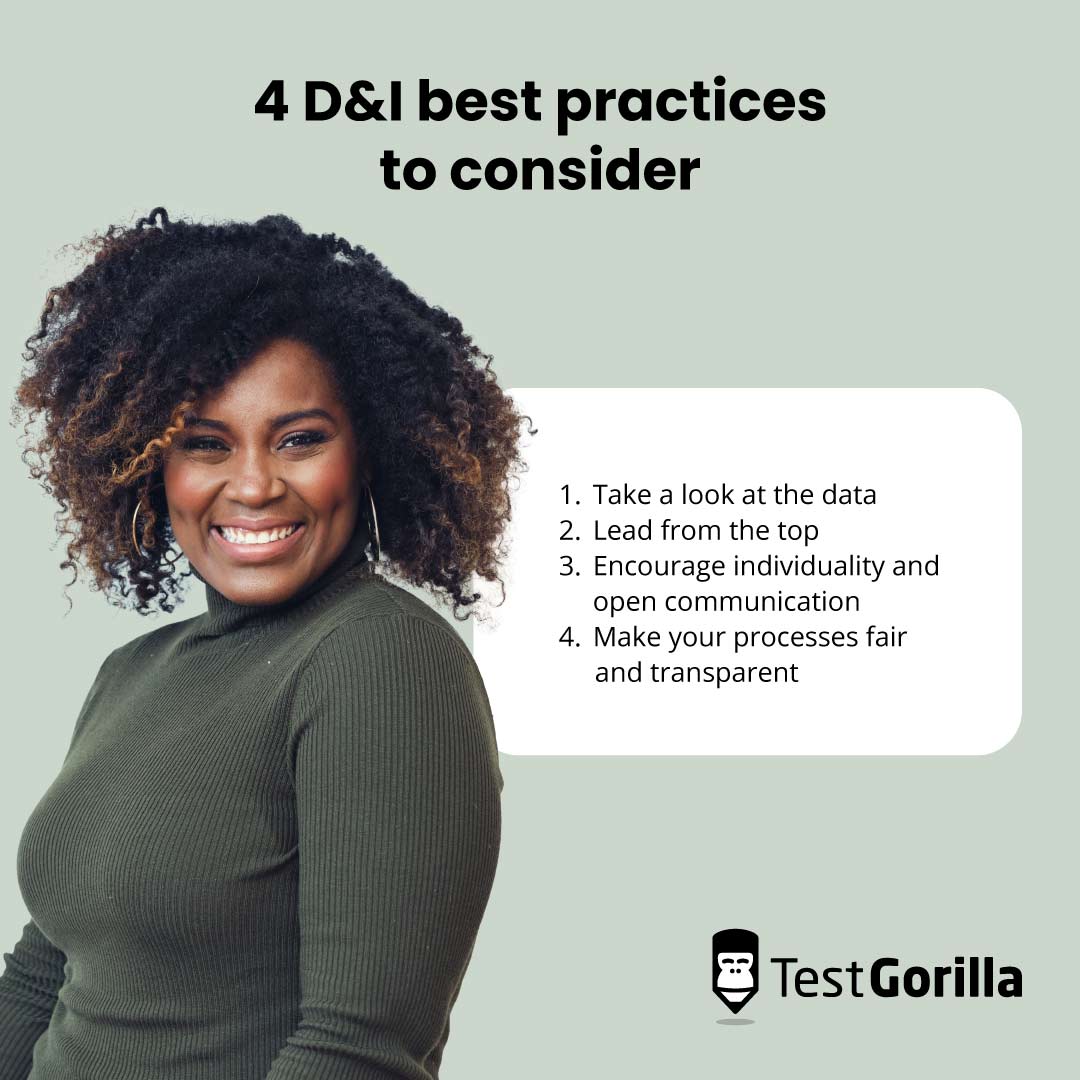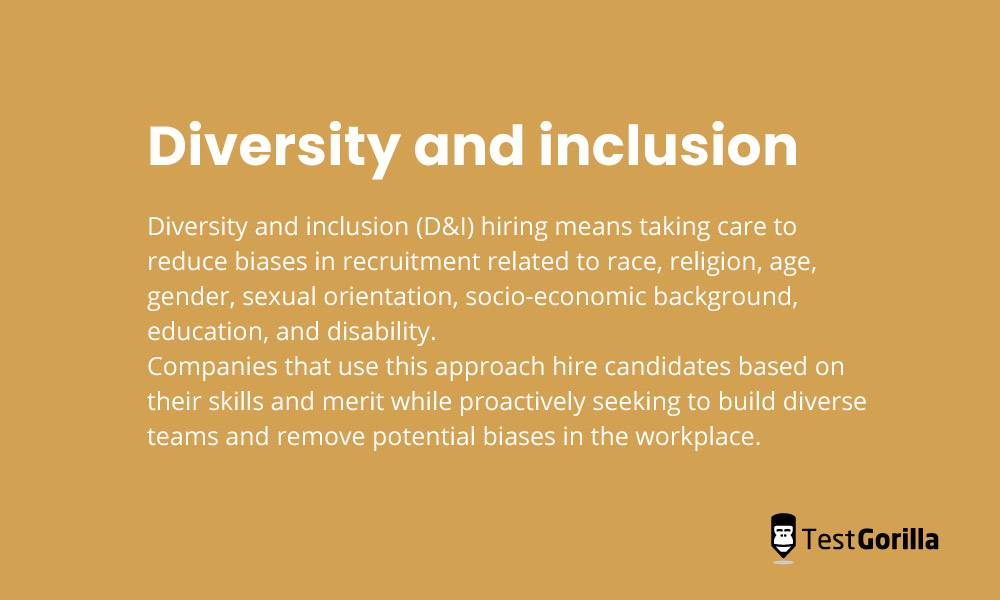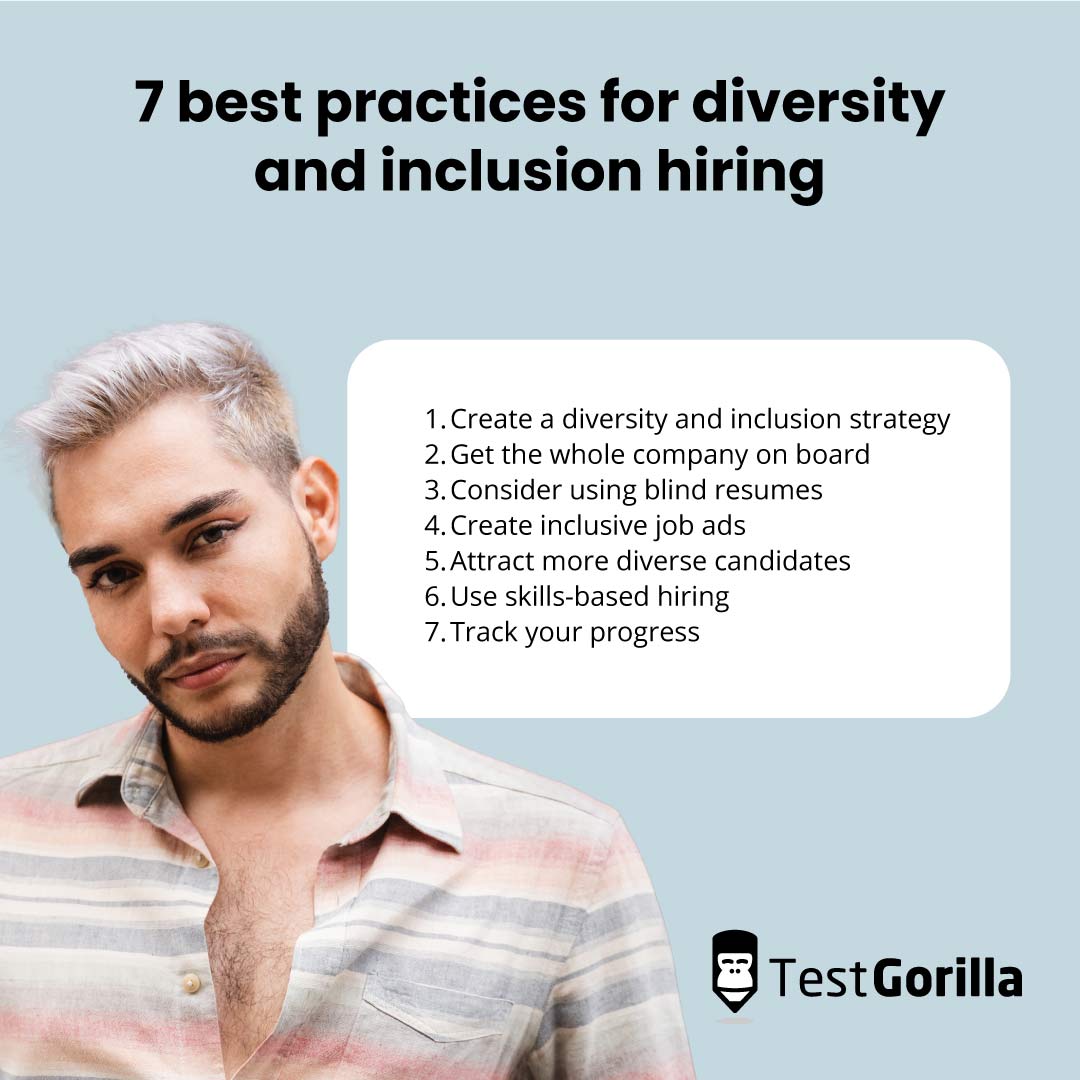When Gap announced its new diversity and inclusion policies in 2020, it imagined it would be celebrated for its hiring approach. But the opposite happened when employees sued the clothing retailer, accusing it of not backing up its claims of diversity in its day-to-day actions.
The benefits of improving diversity in the workplace are well documented: Both gender-diverse and ethnically diverse companies are more profitable than their non-diverse counterparts.
But promising a culture of diversity and inclusion isn’t enough. You need to roll it out to every part of your organization.
In this article, we look at why diversity and inclusion (D&I) is important, how to hire effectively to make your company more diverse and inclusive, and we’ll take you through the best practices you can follow to turn your values and policies into a guide that all your employees will live by.
Let’s start by taking a look at the most common questions surrounding this topic.
Table of contents
Frequently Asked Questions
What is diversity and inclusion?
Diversity is a broad term that encompasses variety in gender, race, age, ethnicity, religion, socioeconomic status, nationality, sexual orientation, as well as cognitive and physical ability.
Diverse organizations recognize and respect the range of characteristics and perspectives present across the workforce. These companies are also more likely to employ people who represent these differences.
Inclusion addresses the culture and environment within which diversity takes place. An inclusive workplace builds systems and processes that enable employees to make the most of their unique talents, skills, and perspectives. Think of inclusion as the critical ingredient that allows diversity to flourish.
Why does diversity & inclusion matter?
In recent years, social justice movements such as Black Lives Matter and #MeToo have placed a sharp focus on diversity and inclusion. In the wake of widespread protests, major companies such as Lowe’s, Tommy Hilfiger, Nike, and Facebook pledged to combat inequality within their organizations and build more diverse and inclusive workplaces.
But staying on the right side of public opinion is far from the only motivating factor for these initiatives. If implemented effectively, D&I can offer a host of benefits to employees and employers alike.
1. It drives innovation and performance
During periods of intense disruption, companies must be dynamic and creative in order to remain competitive. Innovation is the key to this objective. A truly innovative workforce can spin up new products and services, find novel ways to optimize processes and improve quality across all operations.
Diverse teams are able to access these advantages far more easily due to the variety of viewpoints represented within the group. At any moment, you may be confronted with an alternative perspective on a problem you might never have considered previously. Or, you might receive completely unanticipated feedback on a project that forces you to reconsider your objectives.
Indeed, research from the cloud app Cloverpop shows that diverse teams make better business decisions up to 87% of the time and reach consensus on decisions 2.5 times faster than homogenous teams.
2. It increases employee engagement and retention
An inclusive company culture gives many employees a voice and a true sense of belonging. Individuals who feel connected to their work are far more likely to be engaged in their day-to-day activities.
A study conducted by researchers at the University of Georgia and the University of Dublin showed that strong D&I practices significantly improve workplace engagement. These employees are likely to remain in their roles longer than their less engaged counterparts.
3. It creates a strong employer brand
If you’re looking to attract younger Millennials and Gen Z candidates to your company, then a strong focus on diversity and inclusion is a must.
Both of these demographics want to work for companies that are aligned with them on values and that have a culture that is built around those principles. An inclusive workplace that features diverse individuals in both non-leadership and senior positions is the perfect example of this.
The opposite also holds true. A 2022 survey from Deloitte revealed that two out of five Gen Zs and Millenials have rejected job offers due to a misalignment in values.
4 D&I best practices to consider
1. Take a look at the data
Before you can begin implementing a D&I initiative, you need to understand the demographic makeup of your workforce, understand their pain points, and find out what steps you can take to give underrepresented groups a greater sense of belonging. There are a few possible sources for this information.
Basic employee details can likely be retrieved from your HRIS system to other reporting tools used for onboarding.
For qualitative data, you may need to set up internal surveys to get an objective look at what your employees are thinking. It’s important that respondents are allowed to submit their answers anonymously so that they can feel free to share their opinions without worrying about potential consequences or the misuse of their information.
2. Lead from the top
Inclusive leaders who show a strong awareness of their own biases and make a concerted effort to listen to diverse voices from within their organization are critical to the success of D&I initiatives. Data from Deloitte shows that these individuals can increase the proportion of employees who feel included by up to 70%.
Apart from modeling the right behaviors, leadership teams can inspire a culture of inclusivity by setting clear objectives around D&I and committing to them on an individual level.
3. Encourage individuality and open communication.
Employees should feel comfortable bringing their true selves to work without having to mask essential aspects of their identity. The key to fostering this kind of culture is open and honest communication. In addition, managers should endeavor to understand and promote diversity within their teams and affirm their support for team members struggling to find a sense of belonging at work.
This attitude can be formalized in guidelines outlining how employees should communicate with each other and how workplace norms can be adjusted to enable a more inclusive workplace culture. There should also be strict policies against discriminatory language, harassment, and exclusionary behaviors.
4. Make your processes fair and transparent.
One of the biggest roadblocks to diversity and inclusion is unfair practices that prevent underrepresented groups from accessing opportunities within the organization.
Examples of these obstacles include employee referral programs that tilt hiring processes in favor of candidates that look, think, and act like your existing employees. Similarly, a system in which pay raises and promotions are based on an individual manager’s evaluations could be ripe for unconscious bias, especially if there is already a lack of diversity in that particular department.
To resolve these issues, it’s important to set up objective criteria on which employee performance, hiring decisions, and promotions can be assessed. These standards should be openly communicated throughout the company so that any discrepancies can be noted and reported immediately.
Of course, D&I hiring is a much broader topic that encompasses many different areas. Let’s take a closer look at how diversity and inclusion affect recruitment.
What is diversity and inclusion (D&I) hiring?
Diversity and inclusion (D&I) hiring means taking care to reduce biases in recruitment related to race, religion, age, gender, sexual orientation, socioeconomic background, education, and disability.
Companies that use this approach hire candidates based on their skills and merit while proactively seeking to build diverse teams and remove potential biases in the workplace.
Since 1964, the American Civil Rights Act has prevented companies of 15 employees or more from practicing racial, religious, or gender discrimination when they hire. But recruiting managers and even AI-driven tools are prone to unconscious bias, and companies need to make a concerted effort if they want to improve D&I among their workforce.
Unfortunately, many recruiters don’t regard this as an important issue: Only 5% of recruiters say hiring for D&I is one of their top three priorities.
Meanwhile, 11% of employees claim D&I initiatives are the first to go when their business needs to cut costs – coming in second to company events and bonuses.
Why is diversity hiring important?
D&I gives businesses a competitive advantage in worker performance. Companies that are inclusive are 120% more likely to hit financial goals, and diverse teams are 70% more likely to capture new markets.
But it doesn’t end there. D&I policies also help employers to motivate and retain their staff.
When employees believe they won’t be discriminated against in the workplace, they’re more likely to look forward to and take pride in their work. Further, a diverse work environment can make employees 5.4 times more likely to stay.
In our 2023 State of Skills-Based Hiring report, we found that the cost of hiring the wrong employee is 24 times their annual compensation. So having a comprehensive D&I strategy for hiring can equate to serious cost savings for your organization.
Additional advantages to diversity hiring include:
Helping hiring managers overcome unconscious bias
Ensuring representation of diverse talent
Strengthening your brand and reputation
Improving employee retention rates
Providing access to a wider talent pool
Improving productivity and promoting higher-quality employee output
Strengthening leadership accountability and trust
Promoting an inclusive company culture
Given the skyrocketing demand for high-growth professionals, you need to go above and beyond to get the best employees. Let’s explore some best practices to help you win the best assortment of talent.
7 best practices for diversity and inclusion hiring
Multicultural and diverse teams are more innovative and creative than homogenous teams and often have a broader range of skills. So embracing D&I hiring practices is a crucial step to creating a more equitable, innovative, and high-performing working environment.
Let’s explore seven best practices to improve D&I hiring in your organization and improve the quality and output of your talent.
1. Create a diversity and inclusion strategy
When employees view their managers as inclusive, their engagement and job satisfaction increases. But unfortunately, half of employees of color and women say they feel undervalued at work. By creating a D&I strategy, you can take positive steps to acknowledge the value of every member of your team.
Johnson & Johnson has set up a global diversity mission to “make diversity and inclusion how [it works] every day.” Its D&I strategy involves fostering employee resource groups, online education, and mentoring programs. And to ensure the strategy is owned by top-level management, the organization’s chief diversity officer reports directly to the chief executive officer and chairman.
So how do you create a D&I strategy and start reaping the rewards of more valued team members? Here are some ideas:
Create a core statement describing what D&I means to your organization and the steps you will take to implement D&I hiring. Start by administering surveys to employees and stakeholders to better understand what it means from a company-wide perspective.
Build a flexible plan that covers your needs, like expanding your recruitment strategy to include a more diverse talent pool or identifying needs and concerns already present within your organization.
Set measurable goals and targets for recruiting particular cohorts. For example, you could hire candidates without degrees, skilled by alternative routes (STAR) workers, or applicants with disabilities.
Use a pre-employment assessment platform to collect applicant data and discover trends. This will make it easier to hire candidates based on their aptitude and skills. Make sure to be transparent about how you’re using this information.
Educate all employees about unconscious bias through company-wide training programs.
Promote psychological safety for people of color, women, and LGBTQ+ workers, and provide mental health-related benefits like therapy.
2. Get the whole company on board
Your D&I strategy needs to extend beyond HR departments and incorporate all teams and stakeholders. But there might be resistance from managers or executives who think the strategy is a box-ticking activity that’s just for HR to worry about.
By publicly announcing your commitment to and investment in D&I hiring, you can get everyone aligned around your strategy.
For example, Adidas created a Global D&I council that includes a range of diverse cross-functional leaders to promote D&I across its workplace, workforce, and marketplace. Most recently, it has committed to filling at least 50% of new hires for all open positions with diverse talent. Here are some other ways to get the whole company on board with your strategy:
Implement communication and training courses to display the value of the strategy, including statistics on organizational benefits like financial gain, increased productivity and creativity, and employee retention.
Offer staff diversity training and host open dialogues between employees of all backgrounds to lessen the effect of unconscious bias and help them examine how they conduct themselves in the workplace.
Provide additional resources like online learning, counselors, reading materials, and mentorship programs.
Make your values and D&I mission clear at the start of employee onboarding. Teach new hires how to not only embody these principles but also flag something they think might go against your D&I policy.
3. Consider using blind resumes
In the seminal study “Are Emily and Greg more employable than Lakisha and Jamal?” researchers found candidates with White American-sounding names got 50% more interview callbacks than those with African American-sounding names despite having the same exact resume.
So it’s no surprise that using blind resumes that keep the candidate’s demographic information hidden helps prevent hiring bias and level the playing field.
For example, Clifford Chance, a UK-based law firm, uses blind resumes for its graduate training program to fairly benchmark candidates based on skills-based criteria over academic requirements. This enables the business to access a broader pool of candidates while giving applicants with unorthodox journeys or experiences an unbiased opportunity.
So, how can you roll out blind resumes in your hiring process?
Refer to your specific D&I mission statement, and determine what your goals are for blind recruitment – for example, increasing the number of ethnically diverse executives at your company. Then decide what parts of the resume you’d like to redact based on your goals, and provide training to HR teams to gauge value add and culture add from resumes with less candidate information.
Use tools like Textio and Pinpoint to help you remove any demographic information from resumes and anonymize applications.
If you’re on a budget or don’t have stakeholder approval for new tools, you can export candidate information as an Excel spreadsheet and delete or hide certain columns, like candidates’ names, to ensure a blind evaluation.
4. Create inclusive job ads
Searching through your open roles and job descriptions is typically the first point of contact a candidate has with your hiring process. So it’s important to make sure your job postings are inclusive and actively winning over diverse candidates.
For example, HubSpot does a great job of emphasizing its desire for diverse candidates in its job postings. Here’s a line taken from its job posting for a contract manager position:
“We are looking for people who contribute to a positive team environment of equality and inclusion.”
Statements like these can help get you more applicants who already align with your mission and values before they start – and boost your chances of delivering on your D&I goals. Here are some other ways you can create inclusive job ads:
Include a D&I statement in your job postings that emphasizes your organization’s inclusive hiring policy and that you particularly welcome applicants from different backgrounds.
Use tools like Diversifier to check your job ads for inclusive language.
Use different types of media (like audio and video) to ensure job postings are accessible to everyone.
Refrain from using gender-specific or coded language. For example, use the gender-neutral terms “mail carrier” or “police officer” instead of “mailman” or “policeman.”
5. Attract more diverse candidates
The way you market your brand and source candidates directly impacts the level of diversity in your candidate pools. So you need to be proactive about making your open positions attractive and accessible to diverse applicants. One way to do this is by posting job descriptions and “we’re hiring” notices on a broader range of platforms. These could include job boards like:
You can also attract more diverse candidates by:
Creating unique company policies or benefits that help your organization stand out and win over people of different backgrounds. For example, flexible hours or a daycare stipend could help attract working mothers with young children.
Using a remote or hybrid working model to open your positions up to a global network of people, no matter their geographic location or visa status.
6. Use skills-based hiring
Skills-based hiring evaluates a candidate’s skills in the early stages of recruitment through skills tests and assessments.
It helps organizations find the best candidate for the role based on their acquired skills rather than relying on their resumes, connections, or education. Skills-based hiring helps you reduce mis-hires, time-to-hire, and cost-to-hire and increases employee retention. But it also enables you to evaluate candidates on data-proven skill sets that are blind to race, gender, sexual orientation, and age – and create a fairer and more equitable workforce.
Skills-based hiring helps you make unbiased hiring decisions and build a diverse team. Since it changes the way you source and select candidates, it makes diversity possible in the workplace. When you give diverse candidates more of a chance – by hiring for proven skills rather than looking at resumes and inadvertently being drawn to people who are similar to you – you make diversity possible. It’s as simple as that.
Wouter Durville, co-founder and chief executive, TestGorilla
Skills-based hiring involves testing hard, soft, and transferable skills for a range of roles and industries. Depending on your needs, you can customize tests for each job profile and the strengths you are looking for in a candidate.
Some tests evaluate specific technical skills, such as Mac computer literacy, JavaScript coding, and financial math skills. Others look at soft or transferable skills, like a candidate’s culture-add potential, communication, and leadership and management skills.
A skills-based approach can also involve take-home tasks, like written work samples and trials that mirror the demands of the job itself. For example, you could create a scenario relevant to the job and see how a candidate handles it. To apply skills-based hiring to your organization, use a pre-assessment platform that automatically sends skills-based tests to candidates and analyzes and reports on their performance. This makes it easy to handle high-volume hiring while making sure you’re always getting the best talent.
By administering various skills-based tests and tasks throughout the application process, you can start to remove unconscious bias from your hiring practices and fully reward candidates based on merit.
7. Track your progress
To ensure your D&I strategy and initiatives are moving the needle, you need to track your progress and keep improving based on your discoveries and feedback.
Remember: This can be a sensitive process that often takes time, but it can also have immediate positive effects like increased trust in organizational leadership and employee loyalty. In fact, employees list authenticity as the number one quality a manager can have in supporting them to do their best work – so even if they make mistakes (which they will), being authentic about their efforts is what matters.
So, what are some ways you can track your progress?
Refer to your D&I mission, goals, and metrics, and cross-reference them with your current standing. Use these to pinpoint any new metrics for measuring success, uncover any patterns, understand any failed initiatives, or mark your growth.
Administer anonymous employee surveys and implement their feedback. By keeping identities anonymous, you’ll get a wider range of more actionable feedback and insights.
Conduct employee interviews across multiple journeys, backgrounds, and skill sets – and candidly ask them what can be improved or what’s working.
Outsource D&I professionals and have them do an audit of your strategy and initiatives for further inspiration or education.
Diversity and inclusion hiring: where skills reign supreme
The majority of companies claim to value D&I. But as Gap found out, these good intentions need to be put into action.
It’s time for everyone to do their part to create a more inclusive and diverse work environment by:
Creating a D&I strategy
Getting the whole company on board
Considering using blind resumes
Creating inclusive job ads
Attracting more diverse candidates
Using skills-based hiring
Tracking your progress
All of this helps to reduce unconscious bias in your place of work and create a more dynamic and interesting company culture.
Want an effective way to hire diverse talent? Skills-based hiring gets you in front of diverse talent pools with all the right skills. Download the report to learn more.
Related posts
Hire the best candidates with TestGorilla
Create pre-employment assessments in minutes to screen candidates, save time, and hire the best talent.
Latest posts
The best advice in pre-employment testing, in your inbox.
No spam. Unsubscribe at any time.

Hire the best. No bias. No stress.
Our screening tests identify the best candidates and make your hiring decisions faster, easier, and bias-free.
Free resources
This checklist covers key features you should look for when choosing a skills testing platform
This resource will help you develop an onboarding checklist for new hires.
How to assess your candidates' attention to detail.
Learn how to get human resources certified through HRCI or SHRM.
Learn how you can improve the level of talent at your company.
Learn how CapitalT reduced hiring bias with online skills assessments.
Learn how to make the resume process more efficient and more effective.
Improve your hiring strategy with these 7 critical recruitment metrics.
Learn how Sukhi decreased time spent reviewing resumes by 83%!
Hire more efficiently with these hacks that 99% of recruiters aren't using.
Make a business case for diversity and inclusion initiatives with this data.





















